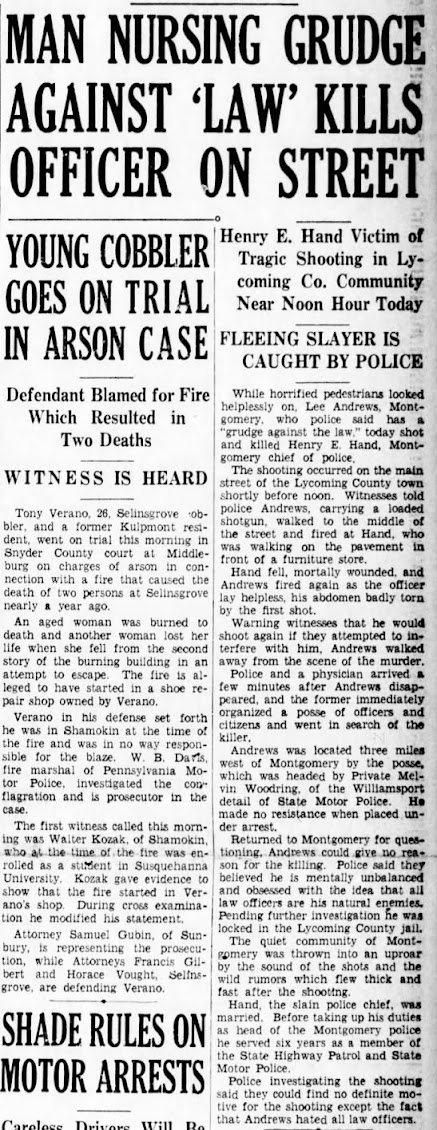1938 was a sad year for the town of Montgomery. In March, their Chief Burgess died in the Last Raft accident. . And then in December, their police chief was murdered by a mentally ill resident, known as the "town character".
Henry Hand had been with the Pennsylvania Highway patrol for six years before he resigned his position, and accepted a job as Chief Of Police for the town of Montgomery Pa. He was in his mid 30s when he and his wife, the former Pearl Rufe, rented an apartment in town. Although neither Hand nor his wife were originally from the immediate area, it didn't take them long to became familiar with Montgomery's residents, and the town's "character".
On the edge of town, in a shack, lived William Leroy Andrews, known as the "town character". The townspeople thought him to be mentally unbalanced, but harmless, and many of them would frequently employ Andrews at odd jobs. He was occasionally arrested for minor nuisances and disturbances, but nothing that made anyone think he was violent or a real danger. Just a bit of a nuisance really. For instance, when Andrews decided a public road should not be open to the public, he took it upon himself to close it - placing wire across it so no one could get through. He wasn't happy when the police removed his wire and told him he couldn't do that, but he didn't hurt anyone, only inconvenienced them Unfortunately, that was about to change.
Henry Hand is standing near the steps in this 1938 photo of Strikers in front of the old Bobbie Brooks factory on E. Houston Avenue.
Love's Hardware is on the right, with the can hanging from the sign. This would later become Murray's Hardware.
As the police chief made his way to Zellers hardware store for this normal meeting with his Chief Burgess, on the morning of Tuesday December 13th, Andrews walked down the other side of the street, shotgun in hand. It doesn't appear that this concerned anyone. Andrews had no history of violence, and he had purchased his shotgun shells in town, no one worried about selling him ammunition. Guns were much more common in 1938 than they were today, and were considered essential for everything from hunting, to dealing with predators, especially on the outskirts of town, where Andrews lived.
But on this day, with no warning, Andrews shot Chief Hand in the stomach, and then again in the back.
As witnesses approached the scene, one heard him say "There he is, I'm going to be chief now!" Then he muttered "He won't bother me anymore, he wont bother me anymore, as he fled the scene. When the witnesses tried to stop Andrews, he threatened them with the shotgun.
Three local doctors, Turner, D'Neill, and Marlett, immediately attended to Chief Hand, but to no avail. He died just as he was to be placed in the ambulance.
An "armed posse" of enraged citizens formed, and were joined before long by a detail of state policemen. Andrews was located in his own yard, still holding the gun. He made threats, but soon offered to go inside of his home if everyone would just leave. With this plan agreed upon, two patrolmen quickly snuck into the house and hid inside, so when Andrews entered and laid his gun on the table, they were able to seize him.
While Andrews gave no reason for murdering the chief, it was believed that he held a grudge for all of the arrests and jail terms he had served, for disturbing the peace.
In his written confession the next day, he stated that he took his shot gun, walked into Montgomery and seeing the officer about to enter Zellers store, fired. He said he didn't like Hand, and suddenly determined to "get him", but he gave no reason for his personal dislike.
In addition to Andrews confession, Mrs William Dukeman, Isaac Breon, and J. S. Johnson had all witnessed the shooting and told the officers that Andrews walked into the street and deliberately shot the Chief. There was no shred of doubt, nor possible confusion, over who was responsible. The only question was why.
One newspaper reported that Andrews had spent some time in Danville State Hospital, but had recently been released due to overcrowding. I'm not certain that is accurate, as no other paper mentioned it.
At his sentencing hearing, Andrews mother testified that he had long been different , and she blamed his condition on a fall from a porch when he was a child. She testified that a doctor told her at the time that "trouble may develop years later". Neighbors testified that Andrews had hallucinations and that he imagined himself to be a federal officer with jurisdiction over all other police. In spite of this, a commission on lunacy failed to find him insane.
Andrews was found guilty of first degree murder, and sentenced to life in prison.
At one point when Andrews was asked why he shot Chief Hand, he stated "One policeman in this town is enough." Hand was the only police officer in Montgomery in 1938. He was also the second official of that borough to meet a tragic death that year, as Chief Burgess Taylor had drowned in the last raft disaster that March.
In 1951, after 11 years in the Eastern Penitentiary in Philadelphia, the warden requested an examination, and Andrews was transferred to Fairview State Hospital for the criminally insane.
William Leroy Andrews died on May 24 1967, at age 62. His body was donated to science.
==========================
For More History & Stories Of Montgomery:
And for more local history & stories -
===============================















No comments:
Post a Comment
I'll read the comments and approve them to post as soon as I can! Thanks for stopping by!